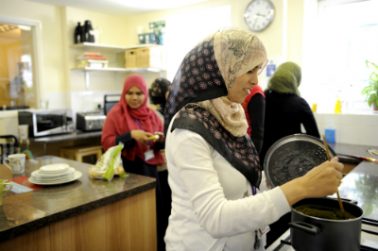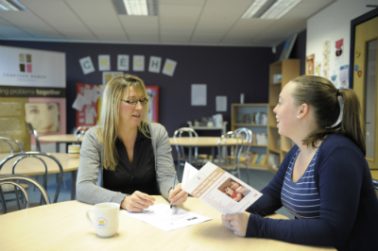What does work for women in the CJS?
- A series of inquiries and reports in recent decades…have all concluded that prison is rarely a necessary, appropriate or proportionate response to women who get caught up in the criminal justice system.5
- The Justice Select Committee, following its inquiry into women offenders, concluded that “prison is an expensive and ineffective way of dealing with many women offenders who do not pose a significant risk of harm to public safety” and called for “a significant increase in residential alternatives to custody as well as the maintenance of the network of women’s centres” seen as “more effective, and cheaper…than short custodial sentences”.5
- Short prison sentences are less effective than community sentences at reducing reoffending. People serving prison sentences of less than 12 months had a reoffending rate seven percentage points higher than similar offenders serving a community sentence—they also committed more crimes.5
- Enabling women to access support for amongst other things, housing, training, drug and alcohol addiction, benefits and debt advice can be a key turning point in breaking the cycle of offending.
- More than half of the women who have accessed Women’s Community Projects provision have consistently engaged with projects for longer than 3 months.
- If alternatives to prison were to achieve an additional reduction of just 6% in reoffending, the state would recoup the investment required to achieve this in just one year. The long-run value of these benefits is in excess of £100m over 10 years.5
- The new economics foundation has found that for every pound invested in support-focused alternatives to prison, £14 worth of social value is generated to women and their children, victims and society generally over 10 years.5
- Of offenders supervised in the community the proportion of women is higher than for the prison population and represents 15.1% of offenders.3
Women arrested
- The total number of arrests decreased by around a quarter between 2008/09 and 2012/13 (from 1.46 million to 1.07 million), with a decrease of around a quarter for males and a third for females. The greater decline in the number of arrests of females meant that females accounted for a decreasing proportion of all arrests over the five year period, with a year on year decrease from 16.9% in 2008/09 to 15.1% in 2012/13.2
Women in court
- Less than half of women remanded by magistrates’ courts and subsequently found guilty are given a prison sentence.5 In 1993 only a third of women entering custody were sentenced to six months or less. (The Bromley Briefing Prison Fact File (Summer 2014), Prison Reform Trust)
- The rise in the female prison population can partly be explained by an increase in the severity of sentences. In 1996, 10% of women sentenced for an indictable offence were sent to prison; in 2014, 16% were.5
Women in custody (prison doesn’t work)
- The average cost per woman prisoner in 2015/16 was £42,766, which includes closed, local and open prisons. (MoJ: Costs per place and costs per prisoner by individual prison)
- Reoffending by all recent ex-prisoners costs the economy between £9.5 and £13 billion annually. As much as three quarters of this cost can be attributed to former short-sentenced prisoners—some £7–10bn a year.8
- On 25 November 2016 there were 3,921 women in prison in England and Wales. 8,562 women were sent to prison in the year to June 2016, either on remand or to serve a sentence.8
- As of 21 October 2016 there were 3,857 women in custody. In October 2015 there were 3,848 and October 2013 3,851. The number of women in prison nearly trebled between 1993 and 2005, to 4,470. While numbers had started slowly to reduce, there are still 1,900 more women in prison today than there were 20 years ago.
- The number of women recalled to custody whilst under supervision following their release has increased by over four-fifths (82%) since the end of 2014. 1,379 women were recalled in the year to June 2016.8
- 70% of sentenced women entering prison in the year to June 2016 were serving six months or less.8
- 26% of all women in prison and 28% of women serving sentences of under 12 months had no previous convictions, compared to 12% of men.
- Family and friends are the most important factor in enabling successful resettlement on release. Despite this, inspectors found no evidence that families were involved in sentence planning, even when a person said they were relying on them for support after release.8
- 33% of women in prison are aged 40 and over.5
- Women represent 5% of the overall prison population. (Women in prison (August 2012), Prison Reform Trust)
- Women released from custody having served a sentence of less than 12 months are more likely to reoffend than those who received a community order; in 2008 the difference in proven reoffending rates was 8.3%.1
- Substance abuse treatment programmes, particularly when delivered in prison, can reduce women’s offending. However the number of women starting and completing substance misuse programmes fell by 92% and 89% respectively between 2009–10 and 2014–15.5
Safety in custody statistics
- Self-harm rates are highest in the younger age groups and decrease with age. Prisoners aged 20 and under accounted for 18.8% of self harm incidents (where age is known), whilst accounting for only 8.5% of the average prison population.3
- Women accounted for 21% of all incidents of self-harm in prison in the year to June 2016 despite representing just 5% of the total population. Whilst this is lower than it has been historically, rates of self-harm amongst women have once again started to rise.8
- In the 12 months to June 2016, there were 7,596 incidents of self-harm by female prisoners, up 6% on the previous year. This is a rate of 1,961 self-harm incidents per 1,000 prisoners, compared with 1,854 incidents per 1,000 prisoners in the previous year.
- There were eight self-inflicted deaths of women in prisons in England and Wales in the year to September 2016 — the highest number since 2007.8
- 70% of people who died from self-inflicted means whilst in prison had already been identified with mental health needs.8
- Inspectors found that many prisons had gaps in primary mental health care, in particular, an absence of counselling services.8
Mothers in prison
- No-one routinely monitors the parental status of prisoners in the UK or systematically identifies children of prisoners, where they live or which services they are accessing. Where this information is collected, it is patchy and not always shared.8
- 40% of prisoners said that support from their family, and 36% said that seeing their children, would help them stop reoffending in the future.6
- Women (51%) were more likely than men (39%) to say that getting support from their family would help them.5
- 35 babies were held in prison in a mother and baby unit (MBU) in March 2016.8
- Applications for admission to an MBU were only successful in 63% of cases where a board made a decision. 64 women moved into a unit in 2015–16.8
- Women with babies in prison may be unable to claim benefits they’re entitled to for their children.5
- All women’s prisons inspected in 2014–15 had been allocated funding to recruit at least one family support worker “who provided excellent broad-based and individual support”.5
Location
- Women are often held further away from their families, making visiting difficult and expensive. The average distance is 64 miles, but many are held considerably further away.8
- At HMP Send women’s prison the average is 76 miles [from their home or court location]; at Askham Grange the average distance from home is 78 miles; for Drake Hall it is 83 miles; and East Sutton Park 91 miles. At Low Newton a third of the women were over 100 miles from their homes. In Eastwood Park prison, where many of the women sent to prison by courts in Wales are sent, 20% of women are over 150 miles from home.5
- Following the closure of HMP Holloway last year there is now no prison for women in London. Women are now sent 23 miles away to HMP Bronzefield in Surrey; 19 miles away to HMP Downview on the Surrey border; over 90 miles to HMP Peterborough or even further afield.8
- Family contact can help reduce the risk of reoffending on release. Keeping in touch with loved ones is often made more difficult by being held in prison, many miles away from home. The average distance for women is 64 miles, but is often significantly more.8
On remand
- Over half of women entering custody do so on remand. These women spend on average six weeks in prison and six out of ten of them do not then go on to receive a custodial sentence.
- In 2010 19% of the female population was on remand. That figure – at 524 – is now 14%. 45% of women prisoners first entered prison on remand. However, less than half of women remanded by magistrates’ courts and subsequently found guilty receive a prison sentence.
- The number of women entering prison on remand awaiting trial is falling. 3,489 women were sent to custody ahead of their trial in 2014—a drop of more than a quarter since 2009.5
Release
- Women are often inadequately prepared for release from prison. Just 8.5% of women leaving prison secured employment.8
- Only 12% of employers surveyed said that they had employed somebody with a criminal record in the past three years. One in five employers said they either did or were likely to exclude them from the recruitment process.6
- 37% of prisoners said they needed help with their accommodation on release—only 22% reported getting it.5
- One in five people (20%) said they had no accommodation to go to on release—15% reported being homeless shortly after release.5
- Almost three-quarters of prisoners surveyed said finance, benefits and debt were a very significant need on release—second only to accommodation.5
Release on Temporary Licence
- The number of days women were released on temporary licence was 1005 per 100 prisoners.3
Reoffending
- Women released from prison are more likely to reoffend, and reoffend earlier, than those serving community sentences.5
- 48% of women are reconvicted within one year of leaving prison. This rises to 61% for sentences of less than 12 months and to 78% for women who have served more than 11 previous custodial sentences.8
The ‘crimes’
- 81% of women are serving a prison sentence for a non-violent offence.8
- 42% entered custody under sentence in 2015 for theft and handling stolen goods.6
- Fewer women are in prison for drug offences in the last ten years (June 2006 - 1163, 2010 - 829 and 2015 - 420) however the number in custody for violent offences has gone up (June 2006 - 678, 2010 - 898 and 2015 - 913).
- More women were sent to prison to serve a sentence for theft and handling than for violence against the person, robbery, sexual offences, burglary, fraud and forgery, drugs, and motoring offences combined.5
- 66% of women and 38% of men in prison report committing offences in order to get money to buy drugs.5
- A survey of prisoners found that nearly half of all women (48%), compared to just over one-fifth of men (22%), reported having committed offences to support someone else’s drug use.5
- 14% of women in prison are serving sentences for drug offences.8
- A Cabinet Office study found that 28% of women’s crimes were financially motivated, compared to 20% of men’s.5
- Theft offences accounted for nearly half (49%) of all custodial sentences given to women. Most received sentences of three months or less.5
- Between 2009–2014 the number of women sentenced for theft offences decreased by 6% whilst the number sentenced to custody increased by 20%.5
Women who offend are often victims
Many women have multiple and therefore more complex problems related to their offending, high rates of poly-drug use and poor mental health. Many women in custody have themselves been victims of serious crime and sustained abuse. Their needs fall into the following categories:
Abuse / Violence
- 46% of women in prison report having suffered a history of domestic abuse.6
- Over half (56%) of women surveyed said they had witnessed violence between their parents/carers when they were children compared to four in 10 men (41%).5
- 53% of women in prison reported having experienced emotional, physical or sexual abuse as a child.5
- Data indicates that around one in ten (12%) of women with extensive experience of violence have had encounters with the police which involved appearing in court, and that this is much more common than among women with little experience of abuse and violence (1%).7
- Girls who run away from home and women who become homeless, misuse drugs or are exposed to criminality are highly likely to experience further violence in their lives.7
- 50% of women observed violence in the home as a child.8
Education system
- Nearly 40% of women in prison left school before the age of 16 years, almost one in 10 were aged 13 or younger. 30% of women were permanently excluded from school. (The Bromley Briefing Prison Fact File (December 2007), Prison Reform Trust)
Accommodation
- 31% of women in prison report having spent time in local authority care. This compares to 24% of men.5
- 15% of newly sentenced prisoners reported being homeless before custody—9% were sleeping rough.5
- Around one-third of women prisoners lose their homes, and often their possessions, whilst in prison. (Wedderburn, D. (2000) Justice for Women: The Need for Reform, London: Prison Reform Trust)
Substance abuse
- On 30 June 2015 there were 742 women in prison serving a sentence for theft and handling offences—an increase of 5% on the previous year.5
- 52% of women surveyed said that they had used heroin, crack, or cocaine powder in the four weeks prior to custody, compared to 40% of men. However, practitioners report that women may hide or underplay substance misuse through fear of losing their children.5
- Nearly half of women report needing help with a drug problem on entry to prison.8
- 58% of women report having used Class A drugs in the four weeks before custody—compared with 43% of men.8
- More than half (59%) of women in prison who drank in the four weeks before custody thought they had a problem with alcohol. 52% thought their drinking was out of control, and 41% wished they could stop.5
- Considerably higher proportions of women than men said they had a problem with alcohol (30% against 19%) on arrival into prison.5
- Reconviction rates more than double for prisoners who reported using drugs in the four weeks before custody compared with prisoners who had never used drugs (62% vs. 30%).6
Health
- Women in custody are five times more likely to have a mental health concern than women in the general population. They’re nearly twice as likely as men in prison to be identified as suffering from depression (65% versus 37%), and more than three times as likely as women in the general population (19%).
- 49% of women prisoners in a Ministry of Justice study were assessed as suffering from anxiety and depression, compared to 19% of the female population in the UK.4
- 25% of women in prison reported symptoms indicative of psychosis. The rate among the general public is about 4%.6
- 46% of women prisoners surveyed reported having attempted suicide at some point in their lives. This compares with 7% of women in the general population.5
- 76% of remand and 63% of sentenced female prisoners in the sample had a neurotic disorder (depressive episode, Generalised Anxiety Disorder, mixed anxiety and depressive disorder, phobia, Obsessive-Compulsive Disorder and panic), the corresponding figures for men were 59% and 40%.
Family life / children
- According to 2005 research from Alison Liebling two-thirds of imprisoned women are mothers of children under 18. A third of these have children under five, and a further 40 per cent have children between five and ten.
- Only half of the women who had lived, or were in contact with, their children prior to imprisonment had received a visit since going to prison.5
- One Home Office study showed that for 85% of mothers, prison was the first time they had been separated from their children for any significant length of period. It also showed that 65% of mothers in prison were serving their first custodial sentence. (Home Office Research Study 162 (1997), Imprisoned Women and Mothers, Home Office, London)
- A recent MoJ study estimated that 24-31% of all women offenders have one or more child dependents. This is based on data from the police national computer matched with DWP benefits data, identifying female offenders who made a child benefit claim at the time of their disposal in 2012.
- Only 9% of children with mothers in prison are cared for by their fathers in their mother’s absence.
- 15% of prisoners stated that they needed help with problems related to family or children—8% required a lot of help. Women (27%) were more likely than men (13%) to report being in need of help with a problem concerning family or children.5
- 61% of women interviewed at HMP Styal had partners; however a third of these partners were currently also in prison. The same study showed that children had been taken away from 70% of the mothers, and that the remainder were with family.5
- It is estimated that more than 17,240 children were separated from their mother in 2010 by imprisonment.5
- Between April 2005 and December 2008, 382 children were born to women prisoners. This is a rate of almost two births a week in England and Wales. However, information on the number of women who have given birth in prison is no longer collected centrally.5
- When women are sentenced to custody it has a profound impact on family life, just 5% of children stay in their own homes when their mother goes to prison.
- Parental imprisonment approximately trebles the risk for antisocial or delinquent behaviour by their children.4
- More than double the number of children are affected by parental imprisonment than divorce in the family.6
- Children with a parent in prison are three times more likely to have mental health problems or to engage in anti-social behaviour than their peers. (Children of Offenders Review, (June 2007), Ministry of Justice)
- It is estimated that 4 out of 10 young women in prison are mothers.
Foreign national women
- There are 81 different nationalities amongst the foreign national women in prison, with the majority from Romania, Poland, Republic of Ireland, Jamaica, and Nigeria.5
- One in ten foreign national women serving a sentence in prison are there for fraud and forgery offences (usually possession of false documents), and nearly one in three (31%) are there as a result of drugs offences.6
- 11% of women in prison are foreign nationals. Some are known to have been coerced or trafficked into offending.8
Key facts about women taken from:
8 Bromley Briefings Prison Factfile (Autumn 2016), PRT
7 Hidden Hurt, Agenda
6 The Bromley Briefing Prison: The Facts (Summer 2016), PRT
5 The Bromley Briefing Prison Fact File (Autumn 2015), PRT
4 The Bromley Briefing Prison Fact File (Summer 2015), PRT
3 Offender Equalities Annual Report 2014/15, NOMS
2 Statistics on Women and the Criminal Justice System 2013, MoJ
1 Reforming Women’s Justice, Final report of the Women’s Justice Taskforce 2011, PRT



